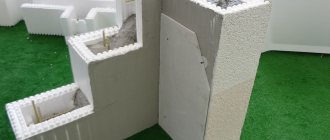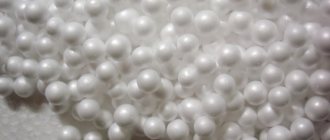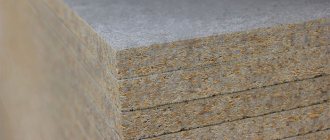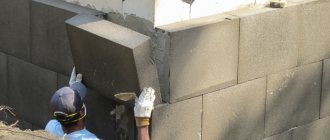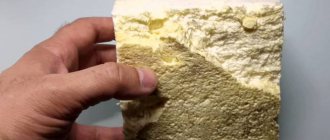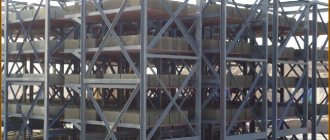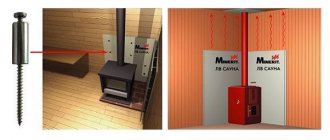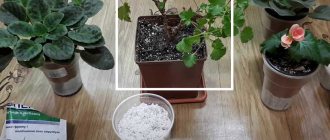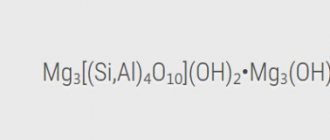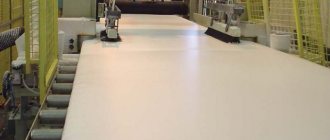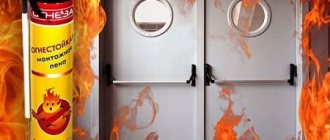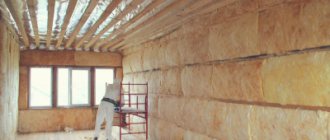Production technology and composition
The chemical composition of the material is similar to polystyrene foam. Its main component is polystyrene foam granules. They are mixed with fire retardants, which reduce flammability, and substances that increase the strength and improve the characteristics of polystyrene foam, and then melted at elevated temperatures. After obtaining a homogeneous molten mass, a foaming agent, carbon dioxide, is introduced into it under high pressure.
After this, the material goes through an extrusion process. The resulting hot mass is forced through the rectangular hole of the extruder. As the pressure drops to normal levels, carbon dioxide expands and foams the mass. Using the size of the extruder hole, the thickness and width of the resulting strip are adjusted. The XPS strip is sawn into slabs of specified dimensions.
The use of extruded polystyrene foam complies with the requirements of SNiP 21-01-97 “Fire safety of buildings and structures”. Federal Law No. 123 regulates the toxicity of combustion products. High-quality EPS has a T2 rating and is classified as a moderately dangerous insulation material. Wood materials, such as parquet, have the same indicator. Production, testing methods, labeling of extruded polystyrene foam are regulated by the requirements of GOST 32310-2012 .
Scope of application of extruded polystyrene foam
Let us consider in more detail the possible areas of use of polystyrene foam boards. Operational and mechanical characteristics allow the active use of polystyrene foam for:
- Thermal insulation of private households and ASG facilities;
- Protection against freezing of the cushions of highways, main pipelines, runways;
- Thermal insulation of foundations, retaining structures and roofs;
- Production of household and industrial refrigeration units, refrigerators;
- Installation of various types of hydraulic barriers;
- Production of packaging and disposable tableware;
- Making household items.
Despite the fact that the scope of use of extruded panels is quite extensive, there are some limitations.
Marking
Foamed polystyrene foam is marked according to GOST and European standards.
According to GOST, the marking must contain the following data:
- Product name
- Manufacturer's name or trademark and address
- Work shift, date of manufacture, workshop of the manufacturer
- Fire safety class
- Thermal resistance
- Thermal conductivity
- Nominal thickness
- Marking code
- Type of cladding or covering, if any
- Length and width
- Number of products in the package and their total area, if necessary
European standards for marking XPS are outlined in document EN 13164:2001 . However, different manufacturers have their own designations for the main characteristics. For example, material under the Penoplex brand has the following markings:
- Type indication – 30, 35, 45
- Designation of grooved surface
- Specifying the selected quarter
- Slab thickness in mm
This marking looks like this: 35GS-30.
Release form
XPS is produced in the form of slabs, substrates and decorative elements.
The slabs have dimensions of 600x1200 and 600x2400 mm. Some manufacturers produce slabs with a width of 600 and 580 mm. Their thickness ranges from 20 to 100 mm. They are supplied to stores in packages. The number of slabs in a package varies and depends on their thickness. Thus, 50 mm thick EPS is sold in packs of 8 pieces, 100 mm thick - 4 pieces.
In addition to slabs, the material is produced in the form of a base for flooring. There is a substrate for parquet, laminate and linoleum. Also, various decorative elements that are made from gypsum can be made from expanded polystyrene. At the same time, the appearance of the products is practically no different from plaster.
Application area
This building material can be used in many construction tasks. There is a special EPP for flooring (fits under laminate, linoleum and parquet). The use of these slabs is permissible even when installing heated floor systems. In addition, due to its low thermal conductivity, EPP is often used in the production of sandwich panels.
The use of this material is permissible when insulating walls and roofs, to form a blind area. Slabs are often used to waterproof foundations.
This material can be used as a filler when the construction of ring-shaped brickwork, characterized by high thermal insulation properties, is required. To a limited extent, these slabs can be used to form a heat-insulating cake that protects sewer and water supply lines from freezing.
Material selection rules
In order to purchase polystyrene foam boards that will have a long service life and safety for people, you need to pay attention to a number of characteristics. When choosing insulation, you should first look at the index indicated on the packaging. If this indicator is less than 28, it is better to refuse to purchase such a product. It is best to purchase an EPP with an index above 40.
In addition, the packaging must provide information about whether the material is suitable for insulating the facade of a house, or whether it can only be used for interior decoration. In addition, it is advisable to choose a material from self-extinguishing polymers.
When purchasing EPP, you need to pay attention to the compliance of the products with GOSTs, because some manufacturers note only technical conditions. The absence of an indication of compliance with GOSTs may indicate that the material has a low density, i.e. with worse performance characteristics.
In order to check the quality of the product, you should break off a small piece of the slab and carefully examine the break point. If small balls are visible on it, this indicates that the product was produced in violation of technology. In high-quality slabs, polyhedra of regular shape will be visible at the fracture.
Extruded polystyrene foam: characteristics
- Strength is in the range of 2-3.6 kgf/sq. cm at 10% linear deformation and 4-7.1 kgf/sq. cm for static bending. The strength of EPS directly depends on its thickness and density.
- Volumetric weight – 15-29 kg/cubic. m and 30-36 kg/cu.m. m. The first is used for insulating houses and industrial buildings and is attached to unloaded structures - walls, ceilings, interfloor ceilings. The second is used to insulate the foundation, floor, roof and other horizontal and inclined surfaces.
- shrinkage of the material under any operating conditions.
- Thermal conductivity is 0.026 W/mG at an average temperature of 10 C. As insulation, polystyrene foam is noticeably superior to other materials. For example, 50 mm thick foam insulation will be equivalent to 20-30 mm EPS.
- Frost resistance . The material loses only 5% of its thermal resistance after 1000 freeze-thaw cycles. The temperature range in which it does not change the physical and thermal parameters is from -50 to +75 C.
- Water absorption is not higher than 0.5% of the volume for 30 days. Low moisture absorption is due to the low capillarity of the material. This allows it to be used in conditions of high humidity and for insulating basements, foundations and roofs. Water absorption occurs only on the surface due to the fact that there are destroyed cells there.
- Vapor permeability depends on the thickness and density of the EPS. Plates with a thickness of 20 mm have a vapor permeability equivalent to one layer of roofing felt. Penoplex brand expanded polystyrene has a vapor permeability coefficient of 0.007-0.012 mg/(m•h•Pa).
- fire resistance class of conventional EPPS is G3-G4. The addition of fire retardants raises the class to G1. The material is not completely non-flammable, but has sufficient fire resistance for use in the construction of buildings and structures.
- The cost of the material is calculated per square meter or cubic meter. Depending on the manufacturer and brand, it ranges from 55-80 rubles/sq. m. or from 3800 rub./cub. m.
- Soundproofing . Impact noise reduction index – 25 dB. XPS refers to materials used for impact noise insulation.
- Environmental friendliness . The insulation is classified as moderately hazardous and has a toxicity class of T2. Not susceptible to decomposition in the environment, the appearance of fungi and mold.
- The service life of extruded polystyrene foam is comparable to the service life of a building. High-quality material lasts more than 40 years, subject to compliance with installation technology.
Technical characteristics of extruded polystyrene foam
The performance and mechanical characteristics of this thermal insulation material require special consideration.
Thermal conductivity
, regardless of brand, lies in the range from 0.03 to 0.04 W/(m·0K). Such indicators make it possible to use expanded polystyrene foam for insulating any building elements, as well as highways, runways, etc.
Density of slabs
, depending on the modification of the material, can be from 20 to 50 kg/m3;
Moisture resistance
. Thanks to the closed porous structure and chemical composition, the material does not deteriorate under the influence of dampness, condensation and even direct contact with water. The only weak point is the end surfaces, the waterproofing of which should be given special attention.
Health safety
allows the use of extruded polystyrene foam even in medical and children's institutions. The plates do not emit harmful fumes even at high temperatures. In addition, the thermal insulation layer is usually covered with a layer of finishing materials (plaster, putty, drywall, etc.).
High strength parameters
. The permissible stress, depending on the modification, ranges from 18 to 20 t/m2.
Other characteristics of extruded polystyrene foam include:
- Frost resistance.
The material retains its thermal insulation properties even at -700C; - Low vapor permeability
, from 0.007 to 0.008 mg/(m h Pa); - The antiseptic properties
of the material practically eliminate the occurrence of fungal colonies; - Long service life
. Regardless of operating conditions, expanded polystyrene foam is guaranteed to last at least 45 years.
Such indicators will certainly arouse increased consumer interest. In addition, it is also important that installation can be done with your own hands, and the cost of the material is relatively low.
Advantages and disadvantages
Advantages of extruded polystyrene foam over analogues:
- Very low moisture absorption
- Durability
- Ease of use and installation
- High thermal insulation capacity
- Strength and ability not to lose shape and volume under different operating conditions
Along with its advantages, it has some disadvantages. Among these is a low level of vapor permeability. As insulation, it is not suitable for all types of premises. If you insulate a residential building with it, it will turn into a thermos that cannot breathe. Another disadvantage is the cost, which is higher than other insulation materials. Although the technical characteristics and price of extruded polystyrene foam are adequate to each other. Finally, the sound absorption of XPS in practice is quite low.
Video on the topic
For quite a long time, polystyrene has been used for insulation of both private and multi-apartment dwellings. This insulating material, like every other, has a number of certain parameters. Its characteristics are very different, but one of the most basic is density. It must be said that the classification of this material is made precisely according to this indicator. Naturally, the scope of application, depending on the density, will also be different.
The advantages of expanded polystyrene are durability, frost resistance, and strength.
